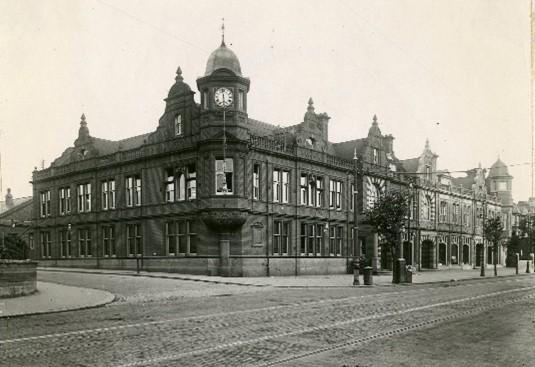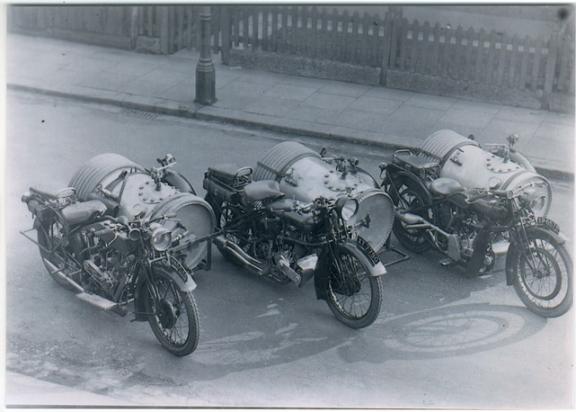Tottenham and District Gas Company
With its green copper dome and clock looking over the High Road, this elegant and unique corner of number 639 has seen a few changes over the last couple of decades.
It began life as the Gas Offices, as it was known locally. Commenced in 1900 and completed by 1913, these impressive showrooms, offices and repair shops were built by Knights the builders of Bruce Grove. It is said the building was erected over the underground Moselle stream (or tributary).

(The showrooms of the Tottenham and District Gas Company at 639 High Road, c.1910. From the collections and © Bruce Castle Museum and Archive)
Back in 1840, the High Road had around 60 gas lamps, supplied from a gas company in Haggerston. A local supply was only achieved by 1845. The gasworks at Willoughby Lane only covered a relatively small area of supply, with the rest brought from Ponders End and Hertford. The Tottenham and Edmonton Gaslight and Coke Company was established in 1847. By 1898, the company had grown and supplied electricity as well as gas, using a a quarter of a million tons of coal each year to generate the gas (find out more about the company). This was a time well before natural gas was supplied via pipes from the North Sea. It was made locally and was getting greater and greater demand. As the company grew to meet this demand, it was also the time to build its new showrooms.

(View north up Tottenham High Road showing 639 High Road, c. 1910. From the collections and © Bruce Castle Museum and Archive)
By 1928 it changed its name, shortening it to the Tottenham and District Gas Co. Twenty years later the 1948 Gas Act brought in by the postwar government nationalised the gas industry, changing how it operated. They merged companies into areas, referred to as Gas Boards.
Gas slurpers
The 1920s saw the gasmen workers who carried out maintenance of the sump gas supplies using ‘sludge gulpers’ – a motorbike fitted with a sidecar that accommodated a large drum or vacuum tank. This contraption on the motorbikes (made at the JAP works – the factory of J.A. Prestwich in Northumberland Park) enabled sludge to be sucked out from the gas sumps into the drum containers. Although the workers might have got about quickly on the bikes, it was more efficient to replace them with trucks and lorries that took over by the mid-1930s.

(‘Sludge gulpers’ used by the Tottenham Gas Company, 1920s-1930s. From the collections of Bruce Castle Museum and Archive. Photograph © Glyn Chambers).
The showrooms were where you could pay your gas and electricity bills or order coal for your home. They also sold gas appliances such as gas fires, cookers, refrigerators and boilers. Through the side gate entrance was the depot, the base for the gas workers.
Bert Hawkes, of Edmonton Hundred Historical Society, wrote about his memories before nationalisation, of enjoying the plush interiors of the Gas showrooms at 639. They were warm from the many gas lamps, fires and ovens being demonstrated to potential customers – it was so pleasant as a refuge on a wet or wintry day, he regretted having to leave once business at the Gas Offices was concluded.
From the days of sourcing of natural gas from the North Sea from 1967, this saw an end of local gasworks as they were once used. The supply of new energy production changed the course forever and gasworks like those at Willoughby Lane were no longer required and demolished. Local artist John Godden captured the demolition of the abandoned works at Willoughby Lane in 1974.

(Demolition at Willoughby Lane Gasworks by John Godden (1930 – 1999). From the collections of Bruce Castle Museum and Archive. © The artist’s estate).
Further resources
A delightful and interesting account ‘When the Gas Man Came To Call: Memories of a retired gasman – in the West Green and St Ann’s Districts N15. 1958 to 1963” by Reginald Chase (Occasional Paper No. 67, edited by Robert Musgrove, Edmonton Hundred Historical Society)
Tottenham & District Gas Company
The 1970s onwards
From 1972, Haringey Council took over number 639 with the offices for Environmental Services, Planning and Building Control, Trading Standards and, later, Customer Services. After the building was damaged during the riots of 2011, the GLA purchased the site and carried out a programme of renovation. Since then, number 639 was transformed to provide spaces for delivering opportunities for young people and creatives. Now known as The 639 Enterprise Centre, in association with the Mayor of London and and operated by social enterprise ‘The Trampery’, it provides facilities and workshop space with training, advice and business support. In 2024, renovation works to the ground floor were completed, featuring a new seminar room, improved café facilities, and enhanced street presence.
Further resources
Location
639 High Road
Tottenham
N17 8AA
United Kingdom